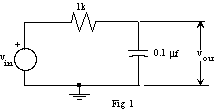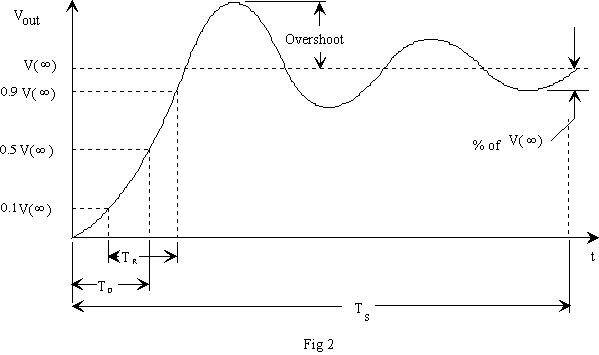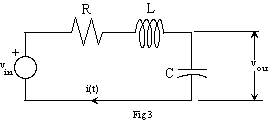
In this lab, you will measure the step responses of RC and RLC networks. Before coming to the lab, calculate and accurately sketch (or plot using MATLAB or Mathcad) the output voltage for each circuit with a step input voltage. Also, calculate the values of R, L, and C you will use in part 2.
1. Construct the circuit shown in figure 1. To observe the step response, drive the circuit with a 0-1 volt square wave (Use the square wave function with the period long enough for the output to come to its final value before the input changes - i.e., a period at least 10 "tau" where "tau" is the longest time constant in the network), and record the response. Display your data in tabular form, as shown below, and compare the calculated and measured values.

| Calculated | Measured | |
| Initial value | ? | ? |
| Final Value | ? | ? |
| Rise Time (TR) | ? | ? |
| Delay Time (TD) | ? | ? |
| Settling Time (TS) within10% | ? | ? |
| Percent Overshoot | ? | ? |
| Time Constant | ? | ? |
These parameters are defined in figure 2.

2. Construct the series resonant circuit of figure 3. We want to build a circuit with a damped sinusoidal response. Chose R, L, and C so that the undamped natural frequency is 100kHz, and the exponential decay of the sinusoid is produced by an "alpha" of 105 (i.e. the sinusoidal response goes to e-1 of its initial value in 10 microseconds). Use one of the following for the value of L (0.47mH, 0.68mH).

3. Observe the step response and compare the theoretical response (Check
page 624 of Thomas and Rosa) with your measurements in a table similar to
that shown below. For this underdamped RLC circuit the response has the form

| Calculated | Measured | |
| Initial value | ? | ? |
| Final Value | ? | ? |
| Rise Time | No calculation | ? |
| Delay Time | No Calculation | ? |
| Settling Time (within 10%) | ? | ? |
| Percent Overshoot | ? | ? |
| "alpha" | ? | ? |
| "beta" | ? | ? |
| "theta" | ? | ? |